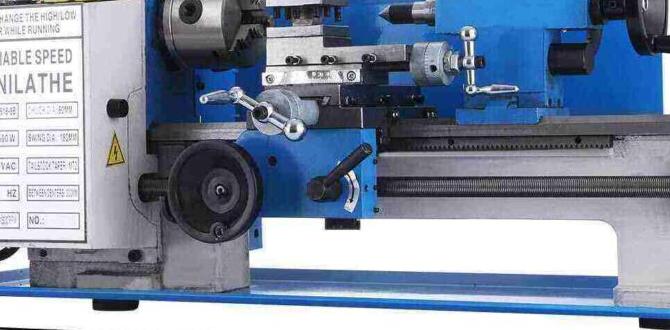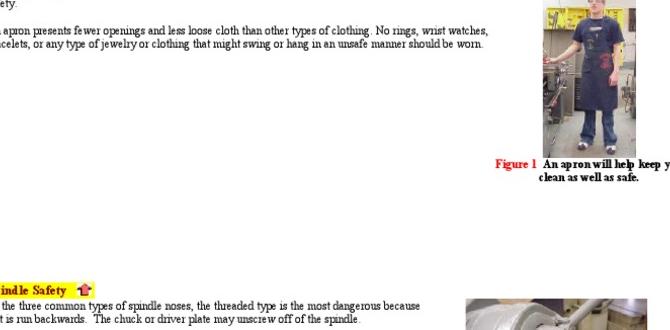Expanding Mandrel For Lathe: Essential Guide
An expanding mandrel for your lathe is a precise tool used to hold hollow workpieces securely from the inside. It’s crucial for operations like turning, grinding, or measuring the outside diameter. Using an expanding mandrel ensures concentricity and accuracy, preventing damage to your material. This guide will walk you through what they are, how they work, and how to choose and use one effectively for your projects.
Hey there, fellow makers and metal enthusiasts! Daniel Bates here from Lathe Hub. If you’ve ever found yourself wrestling with holding onto thin-walled tubes or rings on your lathe, you know the frustration. Getting a perfectly centered and secure grip on something hollow can be a real challenge. That’s where an expanding mandrel shines. It’s like a secret weapon for getting those tricky inside-out jobs done right. Today, we’re going to break down exactly what an expanding mandrel is, why it’s such a handy tool, and how you can start using one with confidence. We’ll cover everything from selecting the right type to using it safely and effectively on your lathe. Let’s get spinning!
What Exactly is an Expanding Mandrel for Lathe?
An expanding mandrel, often simply called a “live mandrel” or “expanding arbor,” is a specialized workholding device. Its primary function is to grip the internal bore of a workpiece, allowing you to machine or measure its external surfaces with great accuracy. Think of it as an internal chuck that expands outward to engage the inside diameter of what you’re working on.
This is particularly important for hollow items like tubes, rings, sleeves, or even some custom-made housings. Unlike an external chuck that grips the outside, an expanding mandrel holds the workpiece from the inside out. This method offers several key advantages:
- Precision: It ensures that external features are perfectly concentric with the internal bore.
- Surface Protection: It avoids marring or deforming the exterior of delicate or finished surfaces.
- Versatility: It can hold a wide range of lumen diameters with the right mandrel.
- Balance: For high-speed operations, a well-mounted mandrel can provide better balance than some external chucking methods.
The basic principle is simple: as you tighten the mandrel, a mechanism causes it to expand radially, creating a tight, friction-based grip against the inner wall of your workpiece. This grip is strong enough to withstand the forces of cutting tools on a lathe.
How Does an Expanding Mandrel Work?
The magic of an expanding mandrel lies in its controlled expansion. While designs can vary, most expanding mandrels work by converting a rotational or linear force into radial expansion. Here’s a breakdown of the common mechanisms:
Mechanical Expansion (Screw Type)
This is the most common and straightforward type. These mandrels typically feature:
- Body: The main shaft of the mandrel.
- Expanding Fingers/Segments: Sloping or tapered segments that are pushed outwards.
- Screw Mechanism: A threaded rod that runs through the mandrel. As you tighten the screw (usually from the tailstock end for live mandrels), it pushes these segments outwards along an angled surface, causing them to expand.
When you insert the mandrel into the workpiece bore and tighten the screw, the segments press firmly against the inside wall. Loosening the screw retracts the segments, releasing the workpiece.
Live vs. Dead Mandrels: What’s the Difference?
The term “live” and “dead” refer to how the mandrel is supported on the lathe.
- Live Mandrel: These are designed to be driven by the lathe’s spindle, meaning they rotate with the workpiece. They have a Morse taper shank or similar feature that mounts directly into the headstock’s spindle (or a chuck mounted in the spindle). This is ideal for machining operations where you need to remove significant material or achieve high precision. The live action means the rotational forces are transmitted through the mandrel, preventing slippage and ensuring consistent cutting speeds. You can find more about live tooling and workholding on the U.S. Department of Labor’s OSHA page on machine guarding, which indirectly emphasizes the importance of secure workholding for safety.
- Dead Mandrel: These are stationary. They are supported between the lathe’s centers. One end of the dead mandrel will have a center hole to engage with the tailstock center. The workpiece is mounted on the dead mandrel, and then the assembly is placed between the headstock and tailstock centers. A drive dog or similar mechanism is used to transfer rotational power from the headstock to the mandrel (and thus the workpiece). Dead mandrels are generally used for lighter operations, inspection, or when the workpiece itself cannot accommodate a drive chuck.
Hydraulic and Pneumatic Mandrels
For highly demanding industrial applications, hydraulic or pneumatic mandrels offer even greater precision and gripping force. These use fluid or air pressure to activate a system of pistons or diaphragms that expand the mandrel. They are typically more complex and expensive but provide superior performance for high-volume or ultra-precision scenarios.
Types of Expanding Mandrels
When looking at expanding mandrels, you’ll encounter a few distinct types, each suited for different tasks and workpiece materials:
1. Tapered Mandrels (Friction Fit)
These are some of the simplest and most common. They feature a tapered shaft with segments or a single tapered sleeve that expands. Tightening a screw or cam mechanism forces the taper to expand the gripping surface.
- Pros: Often less expensive, simple operation.
- Cons: Gripping force can sometimes be limited, and they might require manual adjustment for different bore sizes within their range.
2. Scissor Mandrels (or Leaf Mandrels)
These use a series of interlocking segments or “leaves” that are pushed outward by a central screw mechanism. The leaves provide a more uniform contact area around the bore.
- Pros: Offer good holding power and can grip slightly undersized or irregular bores better than some tapered types.
- Cons: Can be more complex to manufacture, and the contact points between leaves might be a consideration for very thin materials.
3. Ball Expanding Mandrels
These use a cone to push balls outward, which then expand the sleeve or segments. The balls distribute the force more evenly.
- Pros: Can offer very consistent and strong gripping.
- Cons: More intricate design.
4. Draw Bar Mandrels
These are designed to be pulled from the tailstock. A drawbar connects to the expanding mechanism. As you pull the drawbar (often via a lever or pneumatic actuator), the mandrel expands. These are very common in CNC applications.
- Pros: Excellent for automated setups, repeatable expansion.
- Cons: Require a drawbar system on the lathe.
5. Shrink Fit Mandrels
Although not strictly “expanding” in the mechanical sense, shrink fit is a related concept for holding. A mandrel is made slightly larger than the bore. The mandrel is then heated or the workpiece is chilled, creating an interference fit when they reach thermal equilibrium. For heating, it’s crucial to understand thermal expansion. For instance, steel expands about 0.000012 inches per inch per degree Celsius. This principle is used in industries for precise fits. Lathes can be used to create these mandrels or to perform operations on parts that have achieved a shrink fit. While not a direct “expanding mandrel” for lathe use, it’s a powerful internal holding method worth noting.
Choosing the Right Expanding Mandrel
Selecting the correct expanding mandrel is crucial for project success and safety. Here are the key factors to consider:
1. Bore Diameter Range
Mandrels are typically available in specific size ranges. Ensure the mandrel you choose can accommodate the smallest and largest internal diameters of the workpieces you intend to hold. Many mandrels have a range of 2-5 mm (or about 0.08-0.2 inches) of expansion.
2. Required Holding Force
Consider the type of machining you’ll be doing. Heavy cuts require a mandrel that can provide significant gripping force. Lighter operations, like deburring or polishing, might not need as much. Check the manufacturer’s specifications for recommended holding force or applications.
3. Accuracy and Repeatability
For precision work, a mandrel that offers high accuracy and repeatability is essential. Live mandrels are generally preferred for heavy machining due to their ability to maintain concentricity while rotating. For inspection or very light work, a precise dead mandrel might suffice.
4. Workpiece Material and Wall Thickness
Very thin-walled workpieces can be deformed by excessive gripping force from an expanding mandrel. If you are working with delicate materials, look for mandrels designed for those applications, or consider using a mandrel with a softer gripping surface if available, or exert the minimum necessary force.
5. Live vs. Dead Mandrel Requirements
As discussed, your lathe’s setup and the nature of your work will determine whether a live or dead mandrel is more appropriate. For most turning operations on typical hobbyist or small shop lathes, a live expanding mandrel is usually the most versatile choice.
6. Shank Size and Type
For live mandrels, ensure the shank (typically a Morse taper, like MT2 or MT3) matches your lathe’s spindle bore or tailstock. For dead mandrels, the centers need to match your tailstock and spindle centers.
7. Cost and Brand Reputation
Mandrels can range from affordable hobbyist models to very expensive industrial units. Invest in the best quality you can afford from reputable manufacturers. High-quality tooling leads to better results and fewer headaches.
Here’s a quick comparison table for common mandrel types (approximated for general use):
| Mandrel Type | Typical Grip Force | Accuracy | Best For | Cost Range (USD) |
|---|---|---|---|---|
| Tapered (Screw) | Medium | Good | General purpose, light to medium cuts | $80 – $300 |
| Scissor/Leaf | Medium-High | Very Good | Moderate to heavy cuts, holds well on slightly varying bores | $150 – $500 |
| Draw Bar (Pull) | High | Excellent | CNC, repeatable operations, high precision | $200 – $1000+ |
| Ball Expanding | High | Excellent | High precision, demanding applications | $300 – $800+ |
Note: Costs are approximate and can vary significantly based on brand, size, and features.
How to Use an Expanding Mandrel Safely and Effectively
Proper use of an expanding mandrel is key to achieving good results and ensuring your safety. Always prioritize safety first.
1. Prepare Your Lathe and Mandrel
- Cleanliness: Ensure the mandrel and the bore of your workpiece are clean and free from debris, oil, or rust. This is critical for a secure grip and accurate seating.
- Inspection: Check the mandrel for any damage to the expanding segments or threads. A damaged mandrel can lead to inconsistent gripping or failure.
- Lubrication: Lightly lubricate the expanding segments and the screw mechanism with a suitable machine lubricant. This ensures smooth operation and prevents galling.
- Lathe Setup: For a live mandrel, ensure the Morse taper shank is clean and properly seated in the spindle. For a dead mandrel, ensure the centers are clean and lubricated.
2. Mounting the Mandrel
For Live Mandrels:
- Insert the clean, lubricated mandrel shank into the lathe’s spindle bore.
- Ensure it’s fully seated. Tap it gently with a block of wood or soft material if needed, but avoid excessive force. Some live mandrels have a draw bar attachment to pull them securely into the taper.
For Dead Mandrels:
- Mount the centers in the headstock and tailstock.
- Place the dead mandrel between the centers.
- Connect a dog or clamp to the mandrel to engage a drive slot and transfer rotation from the faceplate or chuck.
3. Mounting the Workpiece Onto the Mandrel
For Live Mandrels (most common scenario):
- Insert the workpiece over the stationary (unexpanded) mandrel. Ensure it slides in freely.
- Important: If your mandrel has a tailstock-operated screw, bring your tailstock up to support the end of the mandrel shaft. This provides a stable platform to torque the expanding screw.
- Using the appropriate wrench or driver, begin tightening the expanding screw from the tailstock end. Turn it until you feel resistance.
- Grip Check: Apply a moderate amount of outward force to the workpiece by hand (where safe and possible) to ensure it is firmly seated. On many live mandrels, you’ll simply feel the expansion mechanism tighten. For very critical applications, torque wrenches can be used if specified by the manufacturer, but this is rare for hobbyist tools.
- Critical Safety Note: Do not overtighten. Overtightening can distort or damage your workpiece (especially thin-walled or softer materials), damage the mandrel, or make it extremely difficult to remove. It can also potentially snap the expanding screw. Aim for a snug, secure grip.
- If using a dead mandrel, the workpiece is mounted onto the mandrel between centers, and then the mandrel/workpiece assembly is secured to the lathe’s centers.
4. Performing Machining Operations
- Tool Selection: Use sharp cutting tools appropriate for the material you are cutting.
- Cutting Speed and Feed: Start with conservative speeds and feeds. As you gain confidence, you can adjust based on the tool’s performance and the material. For very thin-walled parts, lighter cuts are essential.
- Monitoring: Continuously monitor the cutting process for any signs of chatter, excessive vibration, or the workpiece loosening on the mandrel. If any occur, stop the lathe immediately.
- Workpiece Rotation: For live mandrels driven by the spindle, the workpiece rotates with the mandrel. Ensure your lathe’s speed settings are appropriate for the diameter of the workpiece.
5. Removing the Workpiece
- Once machining is complete, ensure the cutting tool is clear of the workpiece and the lathe is stopped.
- Loosen the Expanding Screw: Carefully loosen the expanding screw from the tailstock end. Turn it counter-clockwise until the mandrel segments retract.
- Free the Workpiece: Gently tap the end of the mandrel (through the workpiece if necessary and safe) with a soft hammer or block of wood to help break the friction seal if it’s sticking.
- Remove the Mandrel: Once the workpiece is free, remove it. Then, remove the mandrel from the spindle.
Remember that safe operation is paramount. Always follow standard machining safety practices, including wearing safety glasses, keeping hands away from rotating parts, and using proper guards. For more information on safe machining practices, you can refer to educational resources like the National Institute for Occupational Safety and Health (NIOSH), which provides extensive safety guidelines for machine operations.
Common Problems and Troubleshooting
Even with careful use, you might encounter a few hiccups. Here’s how to address them:
- Workpiece is not gripped securely:
- Ensure the mandrel segments are fully engaging the bore.
- Check if the bore is within the mandrel’s size range.
- Are the segments and bore clean? Debris can prevent full contact.
- Is the expanding screw tightened enough? Try a slight bit more, but be cautious not to overtighten.
- Is the mandrel damaged? Inspect the segments for wear or damage.
- Workpiece is difficult to remove:
- Did you overtighten? This is the most common cause.
- Try gently tapping the end of the mandrel while the screw is loosened.
- For very stubborn parts, you might need to carefully apply a penetrating oil (let it sit) or slightly cool the workpiece with a rag soaked in ice water (if compatible with your material and not on a hot part!).
- If it’s a live mandrel, ensure it’s fully retracted by giving the screw a good turn counter-clockwise.
- Workpiece is not running true:
- Is the mandrel properly seated in the spindle?
- Is the workpiece properly seated on the mandrel?
- Is the mandrel itself accurate? Very cheap or worn mandrels might have runout.
- Are you using a live mandrel or a dead mandrel? Live mand




